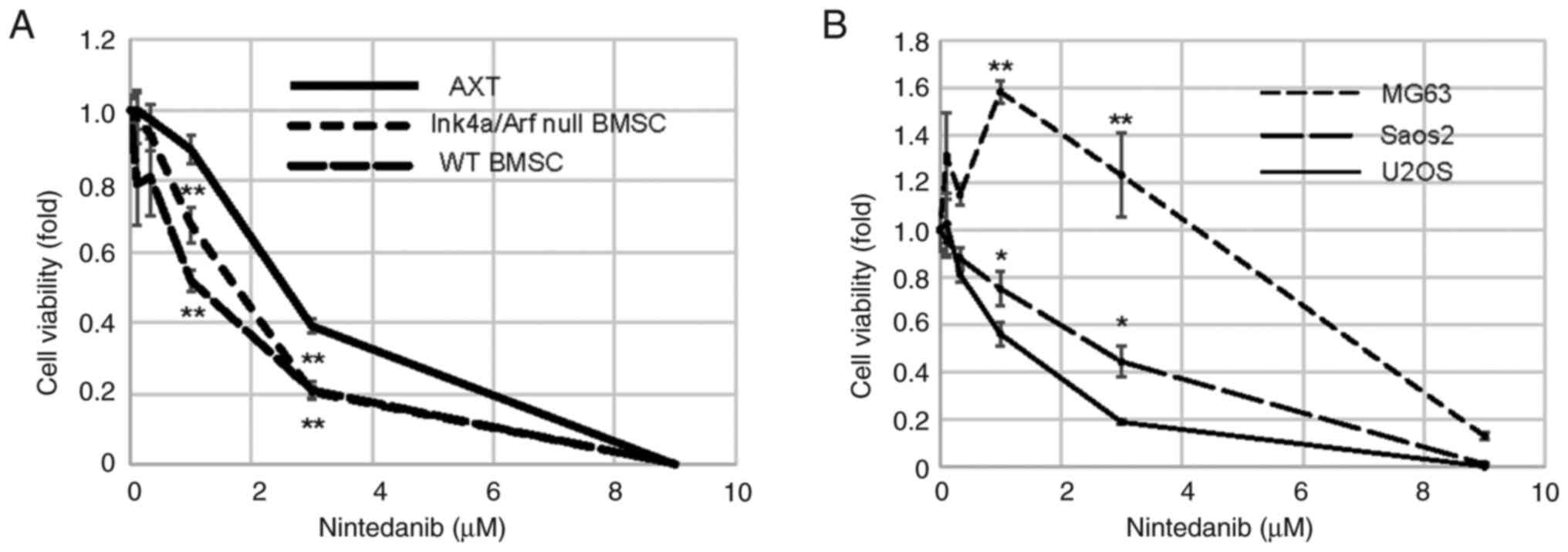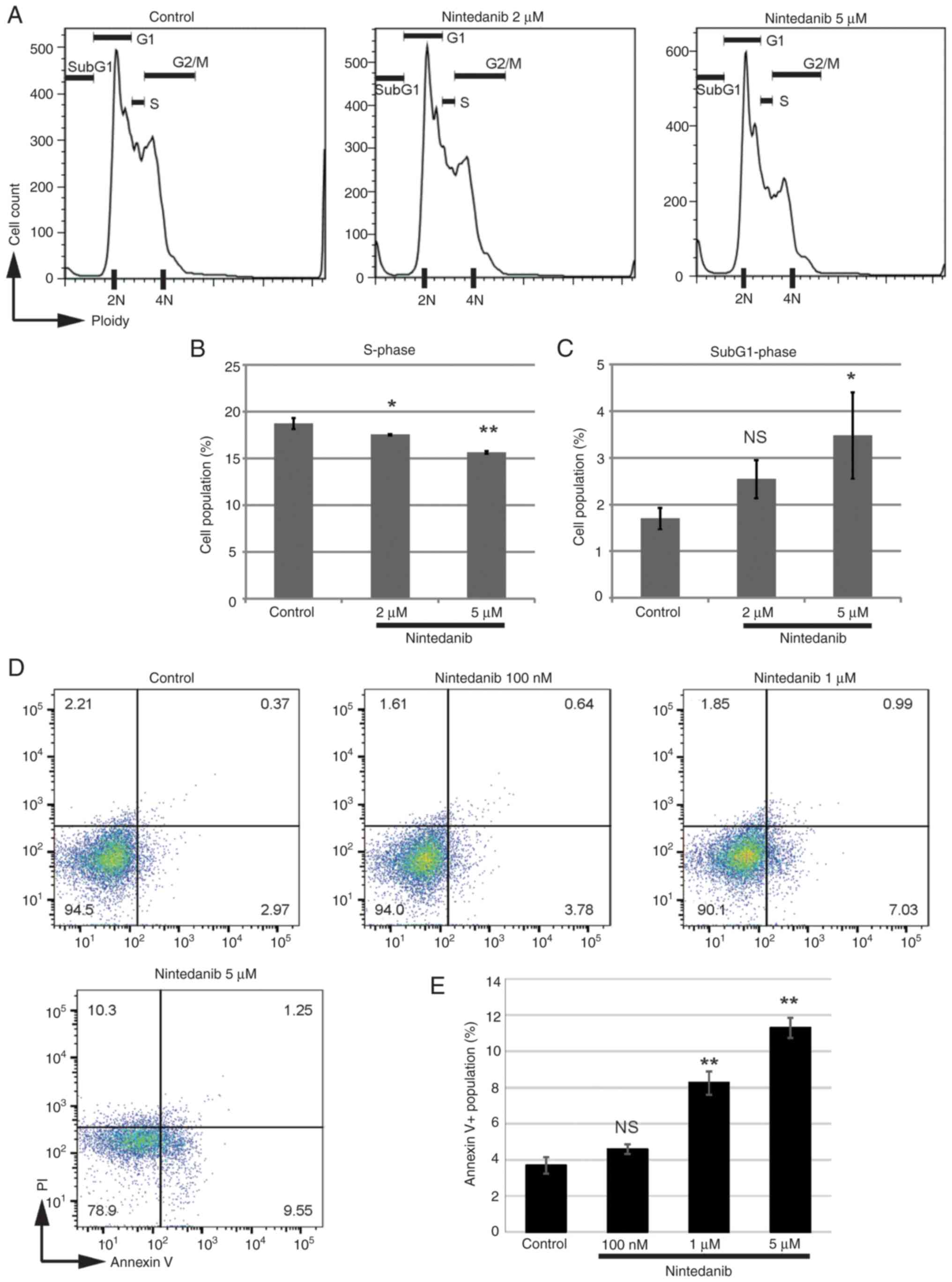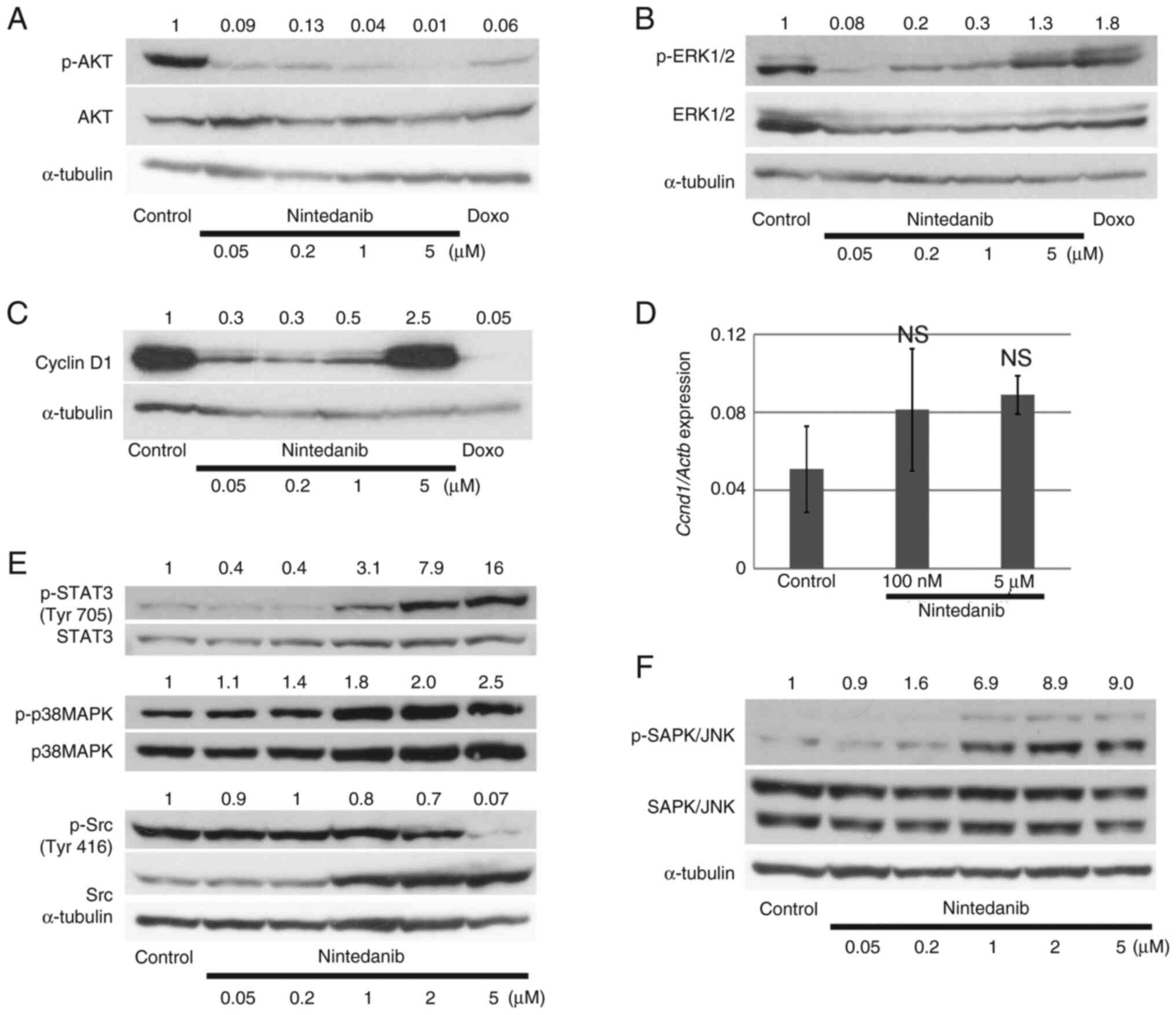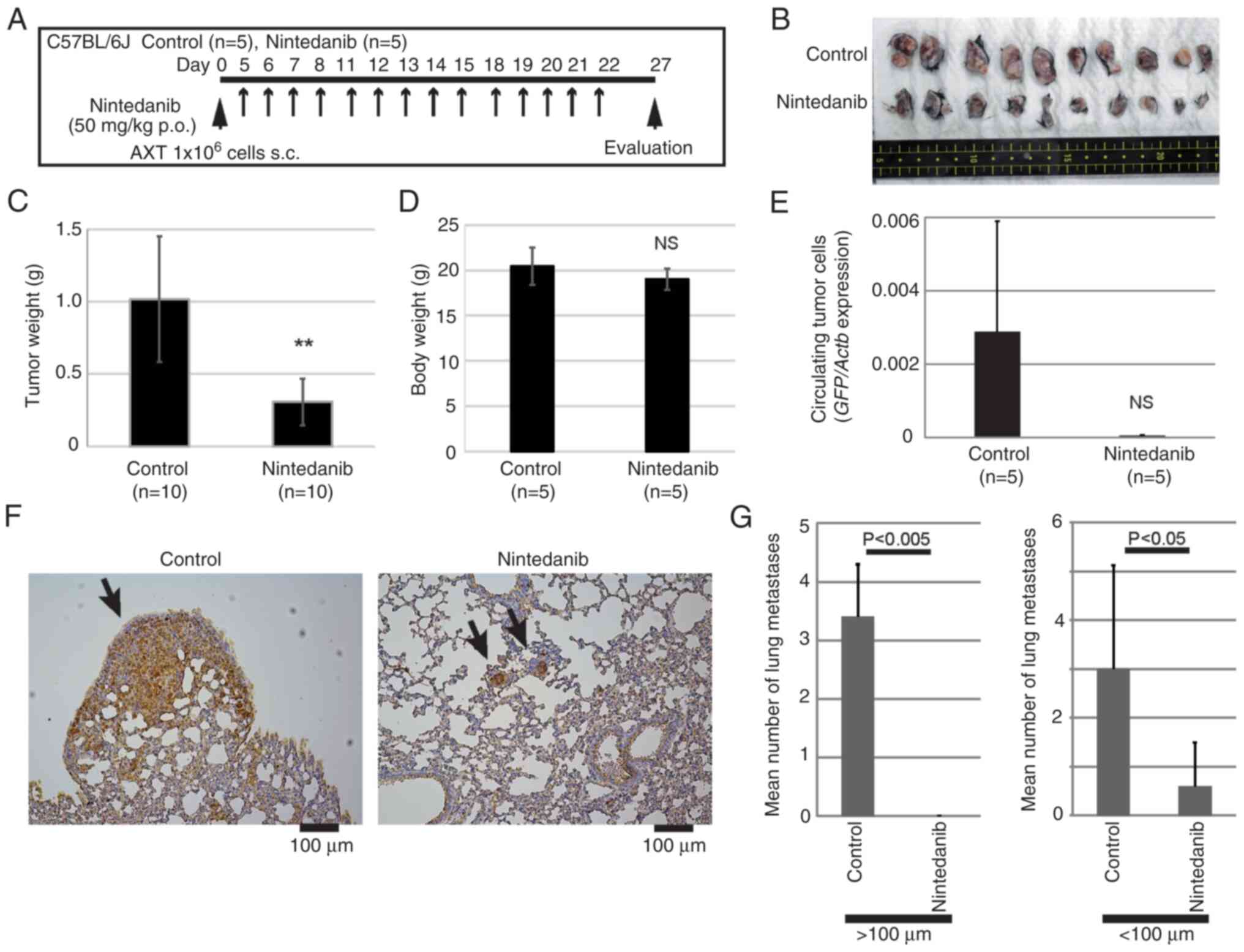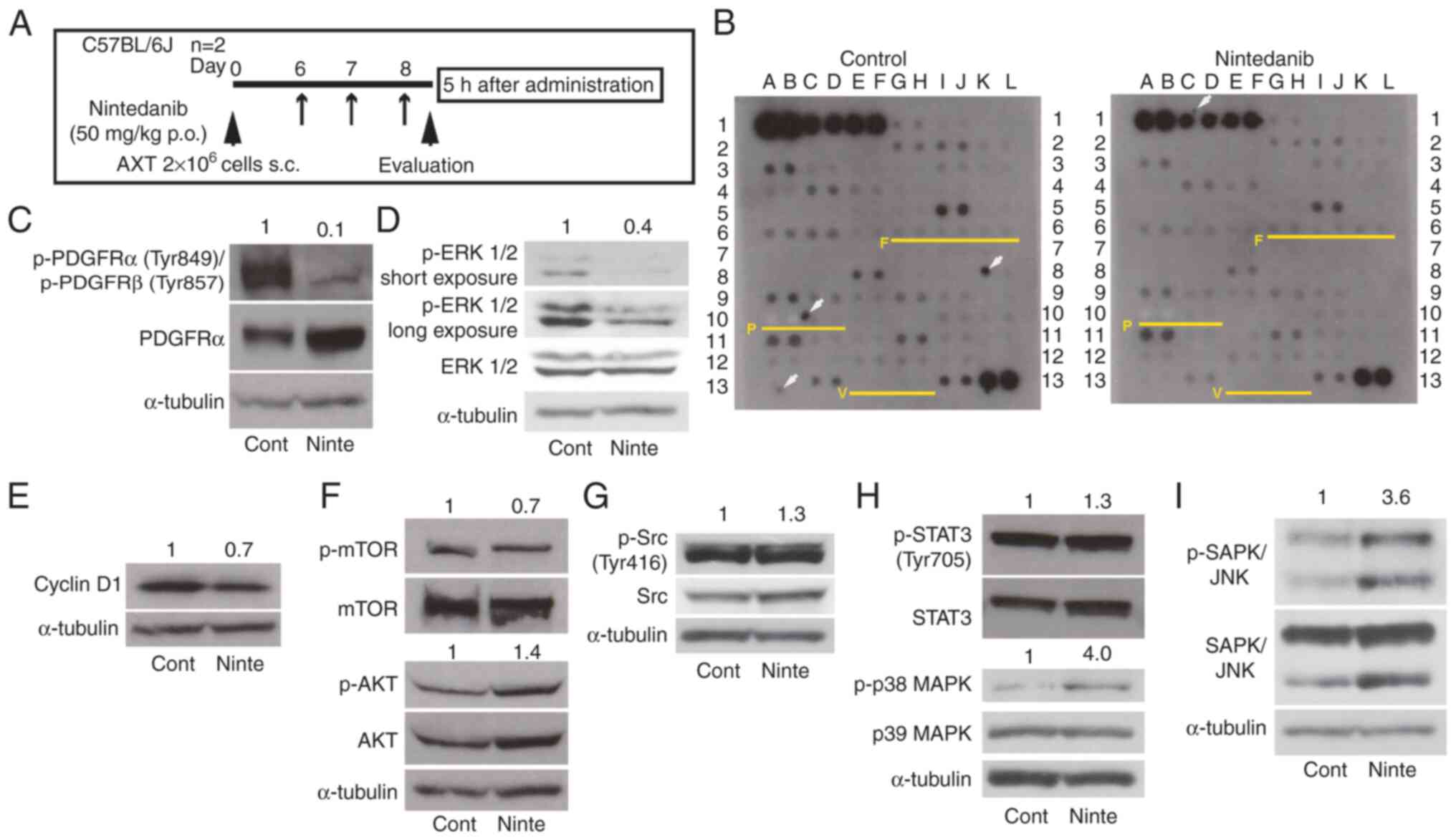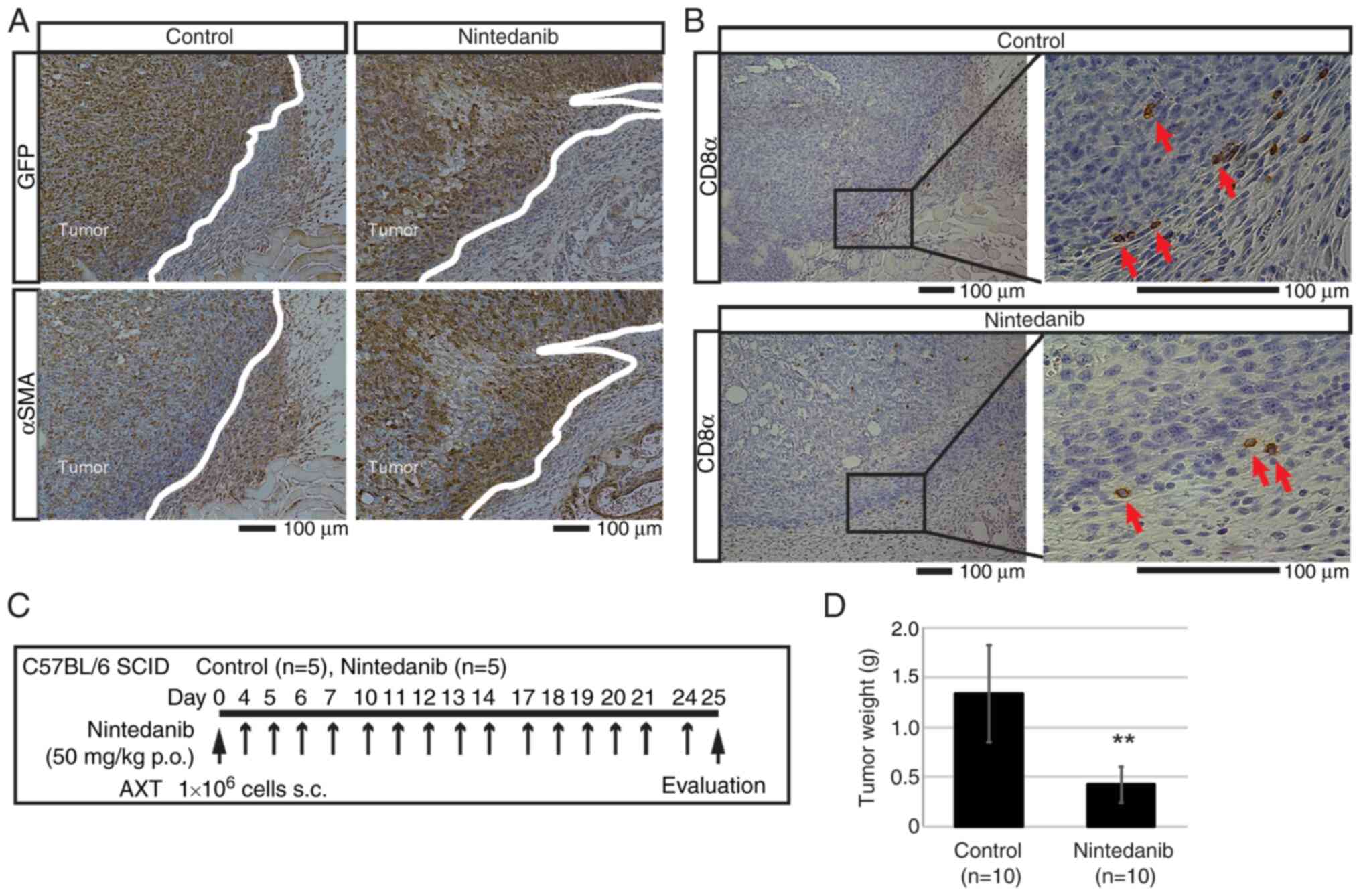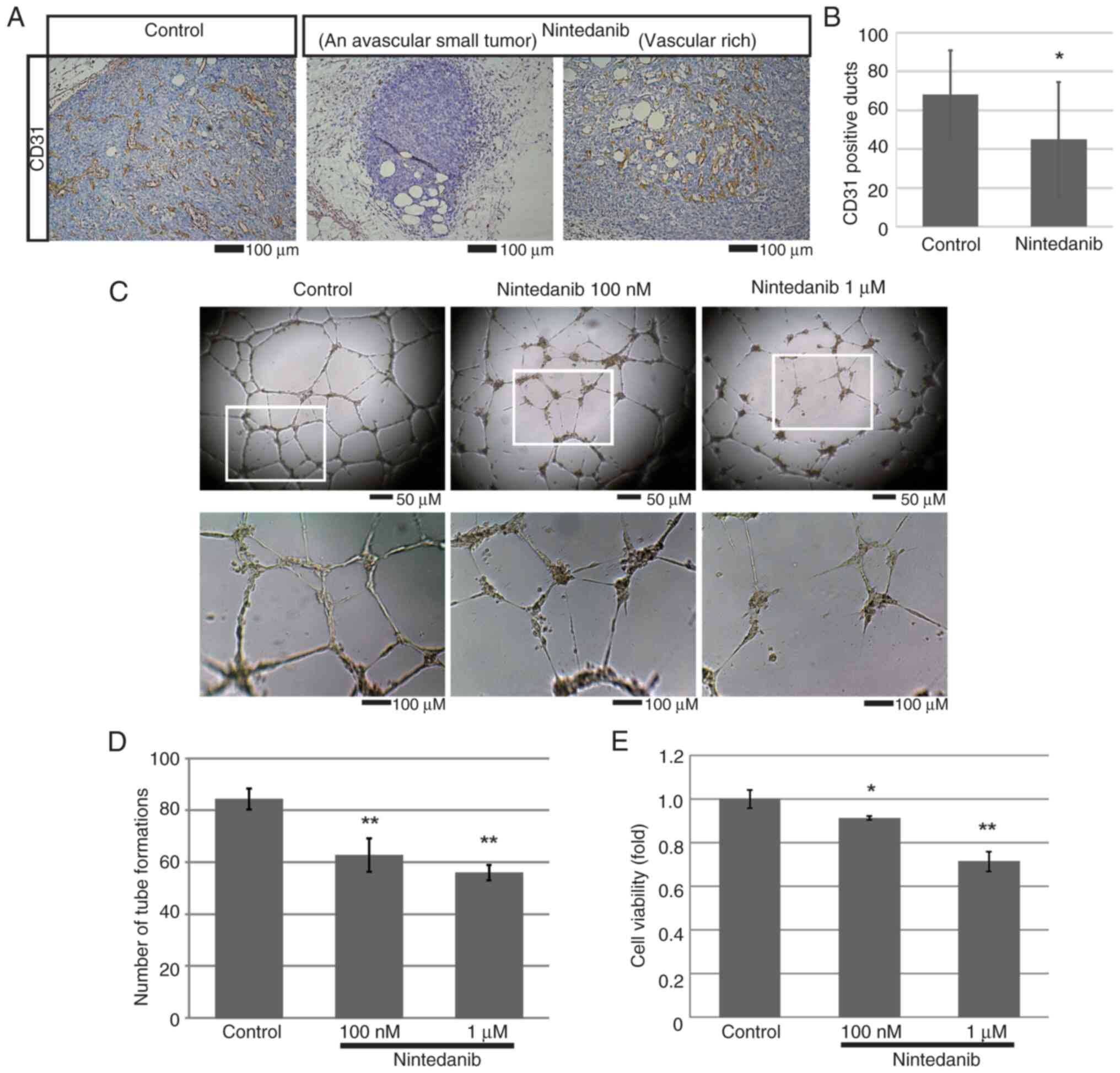Single‑agent nintedanib suppresses metastatic osteosarcoma growth by inhibiting tumor vascular formation
- Authors:
- Published online on: January 25, 2024 https://doi.org/10.3892/ol.2024.14254
- Article Number: 123
-
Copyright: © Shimizu et al. This is an open access article distributed under the terms of Creative Commons Attribution License.
Abstract
Introduction
Osteosarcoma is the most common primary bone tumor in childhood and adolescence. Recent progresses in treatment consisting of surgery and adjuvant chemotherapy have improved prognosis. However, still ~30% of patients do not have long-term survival, mainly due to uncontrollable metastasis (1–4). Thus, novel and safe solutions for overcoming therapeutic resistance must urgently be developed.
Previously, we established a mouse osteosarcoma model using bone marrow stromal cells derived from Ink4a/Arf null mice by overexpression of c-MYC (5). When these osteosarcoma cells, designated AXT cells, were inoculated into C57BL/6 syngeneic mice, lethal tumors with metastatic lesions rapidly develop that mimic the pathophysiology of human osteoblastic osteosarcoma (6–9). Since osteosarcoma develops from mesenchymal origin, agents that suppress the function of mesenchymal cells such as fibroblasts might also exert anti-osteosarcoma in vivo.
Nintedanib (formerly known as BIBF 1120) is an oral small-molecule anti-fibrotic drug that is a triple angiokinase inhibitor; the drug inhibits fibroblast growth factor (FGF), vascular endothelial growth factor (VEGF), and platelet-derived growth factor (PDGF) signaling pathways (10–12). Nintedanib is FDA-approved for treating idiopathic pulmonary fibrosis (IPF) and advanced lung adenocarcinoma (12–15). Preclinical in vitro and in vivo studies have shown that nintedanib exerts an anti-tumor effect in various types of cancers including non-small cell lung cancer, renal cell carcinoma, cholangiocarcinoma, colorectal cancer, ovarian cancer, prostate cancer, and pancreatic ductal adenocarcinoma (10,16–18). Importantly, in addition to directly targeting malignant tumor cells, nintedanib exerts an anti-tumor effect by increasing the sensitivity of the tumor to other anti-tumor drugs and affecting the tumor microenvironment (16,18–20). The influence of nintedanib on the microenvironment suppresses the function of cancer-associated fibroblasts (CAFs) that critically support cancer progression (21–23). Therefore, in vitro studies alone are not sufficient to evaluate the anti-tumor effect of nintedanib and in vivo studies are needed. Clinically, in addition to benefits in non-small cell lung cancer, nintedanib has efficacy in ovarian cancer and mesothelioma either as adjuvant therapy after chemotherapy or in combination with chemotherapy (24,25).
A previous study showed that nintedanib suppresses lung metastasis of osteosarcoma cells by inhibiting fibrotic remodeling of osteosarcoma stem cells, suggesting that nintedanib is useful for treating osteosarcoma metastasis (26). However, the anti-tumor effect of nintedanib in osteosarcoma has not been fully elucidated. In this study, the clinical potential of nintedanib for treating osteosarcoma was examined in vitro and in a mouse model that mimics human disease, and the molecular mechanisms of nintedanib activity were examined.
Materials and methods
Cell culture
Mouse osteosarcoma AXT cells, which were previously established from Ink4a/Arf-null mice by overexpression of human c-MYC (5), or human osteosarcoma cells (U2OS (#HTB-96), MG63 (#CRL-1427), Saos2 (#HTB-85) purchased from ATCC (Manassas, VA, USA) were cultured in IMDM (Nacalai Tesque, Kyoto, Japan) or McCoy's 5A medium (Thermo-Fischer Scientific, Carlsbad, CA, USA), respectively, containing 10% FBS under 5% CO2 at 37°C (27,28). Mouse bone marrow stromal cells (wild-type or Ink4a/Arf null BMSCs) were established as previously described (5). Briefly, bone marrow cells from C57BL/6J or Ink4a/Arf null mice were collected from femurs and tibias and hematopoietic cells were depleted with antibodies to CD45 and lineage-specific antigens. Adherent cells were cultured in IMDM supplemented with 20% FBS and used as BMSCs within ten passages.
Reagents
Nintedanib (#HY-50904 MedChemExpress, Monmouth Junction, NJ, USA) was dissolved in dimethyl sulfoxide (DMSO) at a stock concentration of 20 mM.
Cell viability evaluation
AXT cells or human osteosarcoma MG63, Saos2, and U2OS cells (5×102 in 50 µl of IMDM for AXT cells or McCoy's 5A medium for MG63, Saos2, and U2OS cells, containing 10% FBS) were cultured in a 96-well cell culture plate. Then, 50 µl of the corresponding medium containing test reagents at twice the desired concentrations was added to each well. Cell viability was evaluated using a Cell Titer Glo assay kit (Promega, Madison, WI, USA). Assays were performed at least in triplicate and data are shown as the means ± SD relative (fold) against the corresponding control value for cells incubated in the absence of test reagents.
Endothelial cell tube formation assay
A 96-well cell culture plate was coated with 30 µl of Matrigel (Corning, Corning, NY, USA) and Human Umbilical Vein Endothelial Cells (HUVEC (#KE-4109) purchased from CRABO, Osaka, Japan) cultured with Endothelial Cell Growth Medium (Takara, Shiga, Japan) were seeded after passing through the 40 mm-cell strainer (2×104 in 45 µl of the culture medium per each well). Then, 25 µl of the culture medium with or without 400 nM or 4 µM of nintedanib was added and the final total volume was 100 µl. Tube formation was evaluated after 14 h.
Mouse care
All mouse experiments were performed in accordance with the guidelines of Hoshi University, and the present study was approved by the Committee on Animal Research of Hoshi University (approval number: 20-071). Mice were housed in ventilated cages (five mice/cage; floor area 501 cm2) under specific pathogen-free conditions. Mice were fed a standard chow diet and water ad libitum. Rooms were maintained at 22°C and kept on a 12 h light and dark cycle with inspection every weekday to ensure that they were not under distress throughout the experiments.
Tumor xenograft model
The detailed duration of the experiments and the number of animals used was shown in main figures. Briefly, 1–2×106 AXT cells were suspended in 100 µl of IMDM and injected subcutaneously into the bilateral flanks (two injections in total) of 7-week-old female C57BL/6J mice (SLC, Shizuoka, Japan) or 20-week-old female C57BL/6 SCID mice (The Jackson Laboratory, Bar Harbor, ME, USA) under inhalation anesthesia with 4% isoflurane (Wako, Tokyo, Japan) for the induction and 2% for maintenance.
Nintedanib at 50 mg/kg was orally administered once a day. The endpoint criteria were as follows: i) The mean tumor diameter exceeds 20 mm. ii) The combined tumor burden is more than 15% of body weight (~20 g of 7-week-old mice). iii) Occurrence of ulceration, infection, or necrosis of tumor. iv) Body weight loss is more than 20% of weight. The results did not reach the endpoint criteria in this study. Bilateral two tumors developed in each mouse in this study. The major and minor axes of the bilateral tumors were measured, and the estimated tumor volume was calculated according to the guideline of Washington State University (https://iacuc.wsu.edu/documents/2017/12/tumor-burden-guidelines.pdf/).
Estimated tumor volume (mm3)=d2 × D/2. D and d were the major and minor diameter in mm, respectively. The maximum diameter and the volume of bilateral tumors observed in each mouse was listed in Table SI. When the mice were euthanized, a lethal dose (200 mg/kg) of pentobarbital sodium (Tokyo Kasei Kogyo, Tokyo, Japan) was intraperitoneally injected. Death was confirmed by cardiac arrest. None of the mice was unexpectedly dead or found dead during the study.
Immunoblot analysis
2X Laemmli sample buffer (Bio-Rad, Hercules, CA, USA) supplemented with β-mercaptoethanol was used for the preparation of cell lysate. Immunoblot analyses were performed according to standard semi-dry transfer methods using 5–20% gradient precast polyacrylamide gels (ePAGEL, ATTO, Tokyo, Japan). The primary antibodies were listed in Table SII. Signal intensities were quantitated using the ImageJ software (29), and the relative (fold) values against the corresponding control value normalized against the intensities of the α-Tubulin bands are shown.
Phospho-kinase array
Activated tyrosine kinase in vivo was screened using the mouse RTK phosphorylation antibody array C1 kit (RayBiotech, Norcross, GA, USA). The array map is shown in Table SIII. AXT cells were inoculated into C57BL/6J mice and nintedanib was administrated. The tumor lysate from two tumors of two mice was extracted by disruption using a BioMasher homogenizer (Nippi, Tokyo, Japan). The total cell lysate used was 500 µg.
Cell-cycle analysis
Trypsinized cells were washed with PBS, fixed with 70% ethanol for ≥48 h at −20°C, washed twice with ice-cold PBS, and stained with PBS supplemented with 10 µg/ml propidium iodide and 20 µg/ml RNase. The DNA content of 20,000 singlet cells was measured by FACSVerse (BD Biosciences, San Jose, CA, USA).
Evaluation of apoptosis by flow cytometry
Trypsinized cells were washed with ice-cold PBS, and stained with allophycocyanin-conjugated annexin V (eBioscience, Carlsbad, CA, USA) and propidium iodide. Stained cells were analyzed by FACSVerse. FlowJo software (Tree Star, Ashland, OR, USA) was used for the data management.
Reverse transcription (RT) and quantitative (q)PCR analysis
Total RNA was extracted and RT and qPCR analyses were performed using the NucleoSpin RNA kit and PrimeScript (Takara). To evaluate circulating tumor cells (CTCs), whole blood was collected from the right ventricle of euthanized mice and total RNA was extracted from 200 µl blood with a NucleoSpin RNA blood kit (Takara, Shiga, Japan). Since GFP is constitutively expressed in AXT cells, CTCs were quantitated based on the expression level of Gfp relative to Actb mRNA. The sequences of PCR primers are as follows: GFP forward: 5′-GACGTAAACGGCCACAAGTT-3′, reverse: 5′-TTGCCGGTGGTGCAGATGAA-3′, Ccnd1 forward: 5′-CAACAACTTCCTCTCCTGCT-3′, reverse: 5′-ACTCCAGAAGGGCTTCAATC-3′, Actb forward: 5′-CAACCGTGAAAAGATGACCC-3′, reverse: 5′-TACGACCAGAGGCATACAG-3′. qPCR analysis was performed with StepOne thermal cycler (Thermo Fisher Scientific) with the 2-step protocol; 60 sec at 95°C, then 40 cycles of 15 sec at 95°C and 60 sec at 60°C followed by the melting and dissociation curve analysis.
Immunohistochemistry (IHC)
Immunohistochemical analysis was performed according to standard procedures (5,6,8). Deparaffinized sections were stained with primary antibodies listed in Table SII. Hematoxylin was used for nuclear staining.
Immunofluorescence
Deparaffinized tumor sections were stained with primary antibodies to aSMA (Abcam) derived from rabbit and to CD31 (eBiosience) derived from rat. Alexa Fluor 555-conjugated anti-rabbit and Alexa Fluor 647-conjugated anti-rat secondary antibody (both from Abcam) were used. DAPI solution (Dojindo, Kumamoto, Japan) was used for nuclear staining. Samples were observed with FV3000 confocal microscopy (Olympus, Tokyo, Japan).
Statistical analysis
Unless indicated otherwise, quantitative data are expressed as the means ± SD relative to the control value. All assays were performed at least in triplicate. Data were analyzed with a Student's t-test or one-way analysis of variance (ANOVA) with the Dunnet post hoc test, using Graph Pad Prism 9 (GraphPad Software, San Diego, CA, USA). P<0.05 was considered to indicate a statistically significant difference.
Results
Nintedanib suppresses osteosarcoma cell growth
First, the anti-proliferative effect of nintedanib on osteosarcoma cells in vitro was evaluated. Nintedanib decreased the viability of mouse osteosarcoma AXT cells in a concentration-dependent manner (Fig. 1A). To examine the effect of nintedanib on the non-tumor counterparts of AXT cells, Ink4a/Arf null BMSC and wild-type BMSC derived from the C57BL/6 background were used (5). The growth of both cell lines was also inhibited by nintedanib in a concentration-dependent manner and these cell lines were more sensitive to nintedanib than AXT cells (Fig. 1A). Next, the anti-proliferative effect of nintedanib on human osteosarcoma cells was evaluated. Similar to findings with AXT cells, nintedanib had a direct anti-proliferative effect on human U2OS and Saos2 osteosarcoma cells, but the effect of the drug on MG63 cells was less pronounced (Fig. 1B) and concentrations of nintedanib ≤3 µM did not suppress growth. These results indicate that the effect of nintedanib in osteosarcoma is dependent on cell type in vitro.
Nintedanib suppresses cell-cycle progression and survival signals in osteosarcoma cells
To elucidate the mechanisms underlying the suppression of osteosarcoma cell growth by nintedanib, the cell-cycle status was examined. A 20 h exposure of AXT cells to nintedanib decreased the fraction in S-phase (Fig. 2A and B). Treatment with nintedanib increased the sub-G1 fraction (Fig. 2C), indicating the emergence of apoptotic cells. To further evaluate the induction of apoptosis, AXT cells were treated with nintedanib for 23 h. Although the level of annexin V-positive apoptotic cells was not high, nintedanib concentration-dependently increased the percentage of this cell type (Fig. 2D and E). Together, these findings suggest that nintedanib inhibited cell-cycle progression and increased apoptotic cells in AXT cells.
To clarify the molecular events induced by nintedanib treatment, we evaluated activated kinases by immunoblotting. Phosphorylation of AKT was decreased by 21.5 h treatment with nintedanib or doxorubicin as a positive control (Fig. 3A). The phosphorylation level of ERK1/2 was also attenuated by nintedanib treatment. However, this suppression was not concentration-dependent and ERK1/2 activation was restored by 5 µM nintedanib treatment (Fig. 3B). The expression level of cyclin D1 was downregulated by nintedanib treatment. Notably, similar to the ERK1/2 phosphorylation result, 5 µM nintedanib restored cyclin D1 protein levels to control values (Fig. 3C). Cells treated with 5 µM nintedanib had higher gene expression levels of cyclin D1 than controls, but the level was not statistically significant (Fig. 3D). Thus, the high expression level of cyclin D1 induced by 5 µM nintedanib could be mainly attributable to the accumulation of cyclin D1 protein.
We further examined the activation of signaling molecules downstream of growth factor or cytokine receptors such as IL-6 and CXCL8 which are suggested to be important to promote osteosarcoma metastasis (30–32). Phosphorylation level of STAT3 was not high under the culture with 10% FBS containing medium and tended to be suppressed only at low concentration of nintedanib like p-ERK (Fig. 3E). p38MAPK and SAPK/JNK were activated by the supplement of nintedanib (Fig. 3E and F). These molecules might not be activated as downstream of cytokine or growth factor receptors. On the other hand, Src was inactivated by the supplement of high concentration of nintedanib, consistent with a previous report that nintedanib suppresses many kinases related to Src activation at high concentrations (10).
Collectively, these results showed that nintedanib altered the expression levels of intracellular signaling molecules, but the effect of nintedanib on these molecules was not necessarily concentration-dependent.
Anti-osteosarcoma effect of nintedanib in vivo
We examined whether nintedanib might exert anti-tumor activity against AXT cells in vivo. AXT cells were inoculated into syngeneic C57BL/6 mice and then the mice were treated with a single daily dose of nintedanib at 50 mg/kg (Fig. 4A). Previous toxicity tests using mice reported that no major adverse events occurred when daily 100 mg/kg nintedanib was orally administered for 14 days, and the approximate lethal single dose is over 2,000 mg/kg. The in vivo studies using mouse IPF models demonstrated that a daily dose of 24.9–83 mg/kg nintedanib in mice was efficacious and tolerated when administered for 10 to 30 days (URL: [Ofev, INN-nintedanib (europa.eu)], [https://www.ema.europa.eu/en/documents/assessment-report/ofev-epar-public-assessment-report_en.pdf]). Therefore, we set 50 mg/kg of nintedanib to evaluate the anti-tumorigenic effect.
Administration of nintedanib significantly decreased the primary tumor size and weight (Fig. 4B and C). Treatment with nintedanib did not affect the mouse body weight (Fig. 4D) and all mice were alive, well, and not exhausted during the treatment. Since AXT cells were labeled with GFP, circulating tumor cells could be quantitated (27,28). Treatment with nintedanib decreased the number of circulating tumor cells, although the effect was not statistically significant (Fig. 4E). Consistent with those findings, nintedanib also significantly reduced the levels of lung metastatic lesions (Fig. 4F and G). Notably, large metastatic lesions over 100 µm diameter were not detected in nintedanib-treated mice.
Therefore, these findings show that nintedanib as a single agent exerted an anti-tumor effect on primary lesions and metastatic growth of osteosarcoma.
Nintedanib attenuates PDGFR activation in vivo
To elucidate the molecular mechanisms underlying the anti-osteosarcoma effect in vivo, tumor lysate was prepared from tumors developed in mice inoculated with AXT cells as shown in Fig. 5A, and then the phosphorylation levels of receptor tyrosine kinases per unit of protein were compared. Phosphorylation was still detected in 31 of 71 kinases in the lysate from nintedanib-treated mice (Fig. 5B). FGFR, PDGFR, and VEGFR are the molecular targets for nintedanib (10–12), but phosphorylation levels of FGFR1 and FGFR2 were very weak and not affected by nintedanib treatment. Activation of PDGFRα/β, VEGFR2, and VEGFR3 could not be detected using this phosphorylation array system.
To further evaluate the activation levels of PDGFRs and VEGFR2, the same lysate was subjected to immunoblotting. The activation of PDGFRα/β was attenuated by nintedanib administration (Fig. 5C), suggesting that nintedanib inhibited its molecular targets in vivo. Phosphorylation of Tyr951 or Tyr996 of VEGFR2 was not detected (data not shown). We examined the activation status of downstream molecules. Consistent with our in vitro results at low concentrations, nintedanib decreased ERK1/2 phosphorylation levels (Figs. 3B and 5D). Cyclin D1 was slightly downregulated (Fig. 5E). However, phosphorylation levels of mTOR and AKT were not affected by nintedanib (Fig. 5F).
We evaluated the activation of PDGFR in AXT cells in vitro and compared to the result from the in vivo samples (Fig. S1A). Our previous studies using immunoprecipitation western blotting showed that PDGFR activation was difficult to detect under the culture with FBS containing medium without supplement of PDGF ligands (7). In addition, under the presence of serum in vitro, survival of AXT cells was not dependent on the PDGFR signaling. Consistent with our previous findings, the activation of PDGFR in vitro was considerably weaker than that in vivo. Interestingly, the expression level of PDGFRα increased with nintedanib treatment, but the associated receptor activation was not observed (Fig. S1B). In in vivo tumor samples, phosphorylation status of Src and STAT3 was not attenuated by nintedanib administration (Fig. 5G and H). On the other hand, like in vitro results, p38MAPK and SAPK/JNK were activated by nintedanib administration (Figs. 3E, F, 5H and I). These results suggest that nintedanib does not block STAT3 signaling under 50 mg/kg administration, and p38MAPK and SAPK/JNK might not be activated as downstream of cytokine or growth factor receptors.
Nintedanib suppresses tumor vasculature formation but does not inhibit the enrichment of αSMA-positive cells to osteosarcoma
To clarify nintedanib-mediated histological changes and the mechanisms underlying anti-osteosarcoma effect in vivo, immunohistochemical analyses were performed.
Previous reports suggest that nintedanib exerts anti-tumor activity by inhibiting the functions of CAFs or fibrogenic reprogramming that confers to metastatic ability to osteosarcoma cells (21,22,26). α-smooth muscle actin (αSMA) is a useful marker for smooth muscle cells and a part of fibroblasts including myofibroblasts or CAFs (33,34). In osteosarcoma developed according to Fig. 4A, αSMA positive cells consisted of a variety of cell types; a part of osteosarcoma cells, fibroblastic cells surrounding osteosarcoma (possibly including CAFs), CD31-negative cells localized around blood vessels, and CD31/αSMA double-positive cells (Figs. 6A and S2). However, these cells were also abundant in the tumors of nintedanib-treated mice, indicating that nintedanib treatment did not result in quantitative changes in αSMA-positive cells.
A previous report suggested that nintedanib promoted anti-tumor immunity and potentiated the effects of immune checkpoint inhibitors (23). However, tumor-infiltrating CD8-positive T cells were not numerous in either control or nintedanib-treated mice (Fig. 6B). In addition, nintedanib exhibited anti-osteosarcoma activity in C57BL/6 SCID mice, in which T- and B-cell function is obsolete (Fig. 6C and D).
Next, we evaluated the effect of nintedanib on vasculature formation in osteosarcoma. Immunohistochemical staining revealed that nintedanib reduced the formation of CD31-positive ducts, despite the variable abundance of tumor vasculatures (Fig. 7A and B). To evaluate the effect of nintedanib on vascular formations more directly, endothelial cell tube formation assay was performed. HUVEC formed tubes in 14 h in Matrigel and they became thinner and interrupted by the supplement of nintedanib compared to the control (Fig. 7C and D). Nintedanib treatment also attenuated the viability of HUVEC (Fig. 7E).
These findings indicated that nintedanib exerted anti-tumor activity in our osteosarcoma model mainly by inhibiting tumor vascular formation.
Discussion
In this study, we examined the anti-osteosarcoma effect of nintedanib in vitro and in vivo. Notably, BMSCs were more sensitive to nintedanib treatment than osteosarcoma AXT cells (Fig. 1A). Previous studies indicate that nintedanib exhibits therapeutic effects in idiopathic pulmonary fibrosis, which is an approved clinical indication of nintedanib, by inhibiting growth factor-induced cell proliferation (35,36). BMSCs might show higher sensitivity to nintedanib via the same growth factor-dependent mechanisms. On the other hand, AXT cells, whose viability is driven by oncogenes, might be less dependent on growth factors than BMSCs. Human osteosarcoma cell lines had different susceptibilities to nintedanib, and MG63 cells were less sensitive than the other cell types (Fig. 1B). Several studies have suggested that cell lines of the same cancer type have different susceptibilities to nintedanib (16–18).
In AXT cells, nintedanib treatment decreased the S-phase population and induced apoptosis in a concentration-dependent manner (Fig. 2). However, the concentrations of nintedanib needed to produce this effect were much higher than the IC50 value of nintedanib for inhibiting FGFR, PDGFR, and VEGFR, which is less than 150 nM (10). The suppression of signal activation other than its initial targets might be involved in decreasing the S-phase population and inducing apoptosis in vitro.
The phosphorylation of AKT was suppressed by nintedanib, while a high concentration re-activated ERK1/2 (Fig. 3B). This paradoxical phenomenon was also observed in human bladder cancer cell lines; the authors of that study suggested that high-concentration nintedanib activates signals that are independent of those that control cancer cell sensitivity and viability (19). High-concentration nintedanib in vitro might activate a complex cross-talk of PI3K, MAPK, and other signaling pathways.
Importantly, single-agent nintedanib suppressed the formation of both primary and metastatic lesions of osteosarcoma (Fig. 4). Since PDGFR activation was inhibited in vivo and p-ERK was also attenuated, these findings show that nintedanib inhibited its target molecules in vivo. In in vitro experiments, nintedanib only inhibited cell growth by 10%, even when AXT cells were continuously exposed to 1 µM of nintedanib for 3 days (Fig. 1A). On the other hand, in vivo nintedanib administration reduced tumor size by more than half compared with the control (Figs. 4C and 6D). These findings suggest that nintedanib exerts a stronger anti-tumor effect in vivo. Notably, the nintedanib-mediated inhibition of p-AKT seen in vitro was not observed in vivo (Fig. 5F). Unlike the in vitro environment, the tumor microenvironment consists of complex structures and various cells and factors related to tumor cells (37,38). The continuous activation of AKT that was observed even in the presence of nintedanib is likely due to activation signals from upstream molecules that are not the target molecules of nintedanib (Fig. 5B).
Histological analysis showed that nintedanib significantly suppressed osteosarcoma angiogenesis (Fig. 7A and B). Immunoblot analysis using tumor lysate could not detect the activation of VEGFR, although VEGF is a critical factor for angiogenesis. It is plausible that nintedanib also might block VEGFR activation, which contributes to angiogenesis at levels that were undetectable in this study.
Nintedanib administration did not reduce αSMA-positive cells in osteosarcoma (Figs. 6A and S2). Notably, many tyrosine kinases were still phosphorylated in tumors of nintedanib-treated mice (Fig. 5B). The factors involved in the activation of these kinases might function to maintain the enrichment of CAFs. For instance, EphA3 was shown to be important for the recruitment of CAFs in a mouse lung cancer model (39). The constitutive activation of JAK1was suggested to confer sustained proinvasive ability to CAFs (40).
A previous study showed that nintedanib blocked FGFR-mediated fibrogenic reprogramming of osteosarcoma cells that conferred metastatic ability to primary tumor cells (26). This study clearly demonstrated that originally Fibronectin (FN)/αSMA-negative Well5 cells in the primary bone lesion were changed to FN/αSMA-positive cells during metastatic process through the activation of FGFR signaling. Our previous study also suggests that FGF2 released from the tumor environment suppresses osteogenesis and promotes proliferation and migration of osteosarcoma cells (9). However, regarding the fibrogenic properties, unlike Well5 cells, the primary lesions already contained a lot of αSMA-positive osteosarcoma cells (Fig. 6A), suggesting that AXT osteosarcoma cells in primary lesions originally possess highly malignant properties without the need for FGFR signaling.
Collectively, the results of this study showed that nintedanib has a direct anti-tumor effect on osteosarcoma at concentrations higher than those to block its initial targets in vitro, and more importantly, suppresses osteosarcoma progression in vivo. Nintedanib possibly exerts anti-osteosarcoma effect by modulating the tumor environment rather than directly targeting tumor cells. Therefore, nintedanib could be an effective option for refractory osteosarcoma.
Supplementary Material
Supporting Data
Supporting Data
Acknowledgements
The authors would like to thank Dr Ikuyo Ishimatsu (Keio University) for their technical assistance; and Ms. Honami Ichikawa, Ms. Sae Ichikawa and Ms. Riko Karakama (undergraduate students; Hoshi University) for their experimental assistance.
Funding
This work was supported by KAKENHI grant from the Japan Society for the Promotion of Science (JSPS) (grant no. 21K07134). This work was technically supported by the KAKENHI project JP16H06276 (AdAMS).
Availability of data and materials
The data generated in the present study may be requested from the corresponding author.
Authors' contributions
TS, AS and AM confirm the authenticity of all the raw data. TS contributed to conceptualization, design, acquisition of data, data curation, formal analysis, funding acquisition, investigation, methodology, project administration, validation, visualization and original draft preparation. AS contributed to data curation, statistical analysis, analysis and interpretation of data, and reviewing and editing. YF contributed to acquisition of data. AM contributed to analysis and interpretation of data, supervision and administrative support. All authors have read and approved the final manuscript.
Ethics approval and consent to participate
All animal care and procedures were performed in accordance with the guidelines of Hoshi University, and the present study was approved by the Committee on Animal Research of Hoshi University (approval number: 20-071).
Patient consent for publication
Not applicable.
Competing interests
The authors declare that they have no competing interests.
References
|
Ritter J and Bielack SS: Osteosarcoma. Ann Oncol. 21 (Suppl 7):vii320–vii325. 2010. View Article : Google Scholar : PubMed/NCBI | |
|
Fletcher CDM, Unni KK and Mertens F: Osteogenic tumours: WHO Classification Tumours of Soft Tissue and Bone. IARC Press; Lyon: 2002 | |
|
Jaffe N: Osteosarcoma: Review of the past, impact on the future. The American experience. Cancer Treatment and Res. 152:239–262. 2009. View Article : Google Scholar : PubMed/NCBI | |
|
Moore DD and Luu HH: Osteosarcoma. Cancer Treat Res. 162:65–92. 2014. View Article : Google Scholar : PubMed/NCBI | |
|
Shimizu T, Ishikawa T, Sugihara E, Kuninaka S, Miyamoto T, Mabuchi Y, Matsuzaki Y, Tsunoda T, Miya F, Morioka H, et al: c-MYC overexpression with loss of Ink4a/Arf transforms bone marrow stromal cells into osteosarcoma accompanied by loss of adipogenesis. Oncogene. 29:5687–5699. 2010. View Article : Google Scholar : PubMed/NCBI | |
|
Shimizu T, Sugihara E, Yamaguchi-Iwai S, Tamaki S, Koyama Y, Kamel W, Ueki A, Ishikawa T, Chiyoda T, Osuka S, et al: IGF2 preserves osteosarcoma cell survival by creating an autophagic state of dormancy that protects cells against chemotherapeutic stress. Cancer Res. 74:6531–6541. 2014. View Article : Google Scholar : PubMed/NCBI | |
|
Yamaguchi SI, Ueki A, Sugihara E, Onishi N, Yaguchi T, Kawakami Y, Horiuchi K, Morioka H, Matsumoto M, Nakamura M, et al: Synergistic antiproliferative effect of imatinib and adriamycin in platelet-derived growth factor receptor-expressing osteosarcoma cells. Cancer Sci. 106:875–882. 2015. View Article : Google Scholar : PubMed/NCBI | |
|
Kamel WA, Sugihara E, Nobusue H, Yamaguchi-Iwai S, Onishi N, Maki K, Fukuchi Y, Matsuo K, Muto A, Saya H and Shimizu T: Simvastatin-induced apoptosis in osteosarcoma cells: A key role of RhoA-AMPK/p38 MAPK signaling in antitumor activity. Mol Cancer Ther. 16:182–192. 2017. View Article : Google Scholar : PubMed/NCBI | |
|
Shimizu T, Ishikawa T, Iwai S, Ueki A, Sugihara E, Onishi N, Kuninaka S, Miyamoto T, Toyama Y, Ijiri H, et al: Fibroblast growth factor-2 is an important factor that maintains cellular immaturity and contributes to aggressiveness of osteosarcoma. Mol Cancer Res. 10:454–468. 2012. View Article : Google Scholar : PubMed/NCBI | |
|
Hilberg F, Roth GJ, Krssak M, Kautschitsch S, Sommergruber W, Tontsch-Grunt U, Garin-Chesa P, Bader G, Zoephel A, Quant J, et al: BIBF 1120: Triple angiokinase inhibitor with sustained receptor blockade and good antitumor efficacy. Cancer Res. 68:4774–4782. 2008. View Article : Google Scholar : PubMed/NCBI | |
|
Roth GJ, Heckel A, Colbatzky F, Handschuh S, Kley J, Lehmann-Lintz T, Lotz R, Tontsch-Grunt U, Walter R and Hilberg F: Design, synthesis, and evaluation of indolinones as triple angiokinase inhibitors and the discovery of a highly specific 6-methoxycarbonyl-substituted indolinone (BIBF 1120). J Med Chem. 52:4466–4480. 2009. View Article : Google Scholar : PubMed/NCBI | |
|
Wind S, Schmid U, Freiwald M, Marzin K, Lotz R, Ebner T, Stopfer P and Dallinger C: Clinical pharmacokinetics and pharmacodynamics of nintedanib. Clin Pharmacokinet. 58:1131–1147. 2019. View Article : Google Scholar : PubMed/NCBI | |
|
Richeldi L, Costabel U, Selman M, Kim DS, Hansell DM, Nicholson AG, Brown KK, Flaherty KR, Noble PW, Raghu G, et al: Efficacy of a tyrosine kinase inhibitor in idiopathic pulmonary fibrosis. New Engl J Med. 365:1079–1087. 2011. View Article : Google Scholar : PubMed/NCBI | |
|
Richeldi L, du Bois RM, Raghu G, Azuma A, Brown KK, Costabel U, Cottin V, Flaherty KR, Hansell DM, Inoue Y, et al: Efficacy and safety of nintedanib in idiopathic pulmonary fibrosis. New Engl J Med. 370:2071–2082. 2014. View Article : Google Scholar : PubMed/NCBI | |
|
Reck M, Kaiser R, Mellemgaard A, Douillard JY, Orlov S, Krzakowski M, von Pawel J, Gottfried M, Bondarenko I, Liao M, et al: Docetaxel plus nintedanib versus docetaxel plus placebo in patients with previously treated non-small-cell lung cancer (LUME-Lung 1): A phase 3, double-blind, randomised controlled trial. Lancet Oncol. 15:143–155. 2014. View Article : Google Scholar : PubMed/NCBI | |
|
Kutluk Cenik B, Ostapoff K T, Gerber DE and Brekken RA: BIBF 1120 (nintedanib), a triple angiokinase inhibitor, induces hypoxia but not EMT and blocks progression of preclinical models of lung and pancreatic cancer. Mol Cancer Ther. 12:992–1001. 2013. View Article : Google Scholar : PubMed/NCBI | |
|
Awasthi N and Schwartz RE: Profile of nintedanib in the treatment of solid tumors: The evidence to date. Onco Targets Ther. 8:3691–3701. 2015. View Article : Google Scholar : PubMed/NCBI | |
|
Awasthi N, Hinz S, Brekken RA, Schwarz MA and Schwarz RE: Nintedanib, a triple angiokinase inhibitor, enhances cytotoxic therapy response in pancreatic cancer. Cancer Lett. 358:59–66. 2015. View Article : Google Scholar : PubMed/NCBI | |
|
Marqués M, Corral S, Sánchez-Díaz M, Del Pozo N, Martínez de Villarreal J, Schweifer N, Zagorac I, Hilberg F and Real FX: Tumor and stromal cell targeting with nintedanib and alpelisib overcomes intrinsic bladder cancer resistance. Mol Cancer Ther. 22:616–629. 2023. View Article : Google Scholar : PubMed/NCBI | |
|
Liu J, Gao J, Wang A, Jiang Z, Qi S, Qi Z, Liu F, Yu K, Cao J, Chen C, et al: Nintedanib overcomes drug resistance from upregulation of FGFR signalling and imatinib-induced KIT mutations in gastrointestinal stromal tumours. Mol Oncol. 16:1761–1774. 2022. View Article : Google Scholar : PubMed/NCBI | |
|
Gabasa M, Ikemori R, Hilberg F, Reguart N and Alcaraz J: Nintedanib selectively inhibits the activation and tumour-promoting effects of fibroblasts from lung adenocarcinoma patients. Br J Cancer. 117:1128–1138. 2017. View Article : Google Scholar : PubMed/NCBI | |
|
Yamanaka T, Harimoto N, Yokobori T, Muranushi R, Hoshino K, Hagiwara K, Gantumur D, Handa T, Ishii N, Tsukagoshi M, et al: Nintedanib inhibits intrahepatic cholangiocarcinoma aggressiveness via suppression of cytokines extracted from activated cancer-associated fibroblasts. Br J Cancer. 122:986–994. 2020. View Article : Google Scholar : PubMed/NCBI | |
|
Kato R, Haratani K, Hayashi H, Sakai K, Sakai H, Kawakami H, Tanaka K, Takeda M, Yonesaka K, Nishio K and Nakagawa K: Nintedanib promotes antitumour immunity and shows antitumour activity in combination with PD-1 blockade in mice: Potential role of cancer-associated fibroblasts. Br J Cancer. 124:914–924. 2021. View Article : Google Scholar : PubMed/NCBI | |
|
Ledermann JA, Hackshaw A, Kaye S, Jayson G, Gabra H, McNeish I, Earl H, Perren T, Gore M, Persic M, et al: Randomized phase II placebo-controlled trial of maintenance therapy using the oral triple angiokinase inhibitor BIBF 1120 after chemotherapy for relapsed ovarian cancer. J Clin Oncol. 29:3798–3804. 2011. View Article : Google Scholar : PubMed/NCBI | |
|
Grosso F, Steele N, Novello S, Nowak AK, Popat S, Greillier L, John T, Leighl NB, Reck M, Taylor P, et al: Nintedanib plus pemetrexed/cisplatin in patients with malignant pleural mesothelioma: Phase II results from the randomized, placebo-controlled LUME-meso trial. J Clin Oncol. 35:3591–3600. 2017. View Article : Google Scholar : PubMed/NCBI | |
|
Zhang W, Zhao JM, Lin J, Hu CZ, Zhang WB, Yang WL, Zhang J, Zhang JW and Zhu J: Adaptive fibrogenic reprogramming of osteosarcoma stem cells promotes metastatic growth. Cell Rep. 24:1266–1277.e5. 2018. View Article : Google Scholar : PubMed/NCBI | |
|
Shimizu T, Kimura K, Sugihara E, Yamaguchi-Iwai S, Nobusue H, Sampetrean O, Otsuki Y, Fukuchi Y, Saitoh K, Kato K, et al: MEK inhibition preferentially suppresses anchorage-independent growth in osteosarcoma cells and decreases tumors in vivo. J Orthop Res. 39:2732–2743. 2021. View Article : Google Scholar : PubMed/NCBI | |
|
Shimizu T, Sugihara E, Takeshima H, Nobusue H, Yamaguchi R, Yamaguchi-Iwai S, Fukuchi Y, Ushijima T, Muto A and Saya H: Depletion of R270C mutant p53 in osteosarcoma attenuates cell growth but does not prevent invasion and metastasis in vivo. Cells. 11:36142022. View Article : Google Scholar : PubMed/NCBI | |
|
Schneider CA, Rasband WS and Eliceiri KW: NIH image to ImageJ: 25 Years of image analysis. Nat Methods. 9:671–675. 2012. View Article : Google Scholar : PubMed/NCBI | |
|
Johnson DE, O'Keefe RA and Grandis JR: Targeting the IL-6/JAK/STAT3 signalling axis in cancer. Nat Rev Clin Oncol. 15:234–248. 2018. View Article : Google Scholar : PubMed/NCBI | |
|
Ha H, Debnath B and Neamati N: Role of the CXCL8-CXCR1/2 axis in cancer and inflammatory diseases. Theranostics. 7:1543–1588. 2017. View Article : Google Scholar : PubMed/NCBI | |
|
Gross AC, Cam H, Phelps DA, Saraf AJ, Bid HK, Cam M, London CA, Winget SA, Arnold MA, Brandolini L, et al: IL-6 and CXCL8 mediate osteosarcoma-lung interactions critical to metastasis. JCI Insight. 3:e997912018. View Article : Google Scholar : PubMed/NCBI | |
|
Sappino AP, Skalli O, Jackson B, Schürch W and Gabbiani G: Smooth-muscle differentiation in stromal cells of malignant and non-malignant breast tissues. Int J Cancer. 41:707–712. 1988. View Article : Google Scholar : PubMed/NCBI | |
|
Orimo A, Gupta PB, Sgroi DC, Arenzana-Seisdedos F, Delaunay T, Naeem R, Carey VJ, Richardson AL and Weinberg RA: Stromal fibroblasts present in invasive human breast carcinomas promote tumor growth and angiogenesis through elevated SDF-1/CXCL12 secretion. Cell. 121:335–348. 2005. View Article : Google Scholar : PubMed/NCBI | |
|
Wollin L, Maillet I, Quesniaux V, Holweg A and Ryffel B: Antifibrotic and anti-inflammatory activity of the tyrosine kinase inhibitor nintedanib in experimental models of lung fibrosis. J Pharmacol Exp Ther. 349:209–220. 2014. View Article : Google Scholar : PubMed/NCBI | |
|
Hostettler KE, Zhong J, Papakonstantinou E, Karakiulakis G, Tamm M, Seidel P, Sun Q, Mandal J, Lardinois D, Lambers C and Roth M: Anti-fibrotic effects of nintedanib in lung fibroblasts derived from patients with idiopathic pulmonary fibrosis. Respir Res. 15:1572014. View Article : Google Scholar : PubMed/NCBI | |
|
Labrie M, Brugge JS, Mills GB and Zervantonakis IK: Therapy resistance: Opportunities created by adaptive responses to targeted therapies in cancer. Nat Rev Cancer. 22:323–339. 2022. View Article : Google Scholar : PubMed/NCBI | |
|
Bejarano L, Jordāo MJC and Joyce JA: Therapeutic targeting of the tumor microenvironment. Cancer Discov. 11:933–959. 2021. View Article : Google Scholar : PubMed/NCBI | |
|
Vail ME, Farnsworth RH, Hii L, Allen S, Arora S, Anderson RL, Dickins RA, Orimo A, Wu SZ, Swarbrick A, et al: Inhibition of EphA3 expression in tumour stromal cells suppresses tumour growth and progression. Cancers (Basel). 15:46462023. View Article : Google Scholar : PubMed/NCBI | |
|
Albrengues J, Bertero T, Grasset E, Bonan S, Maiel M, Bourget I, Philippe C, Herraiz Serrano C, Benamar S, Croce O, et al: Epigenetic switch drives the conversion of fibroblasts into proinvasive cancer-associated fibroblasts. Nat Commun. 6:102042015. View Article : Google Scholar : PubMed/NCBI |



